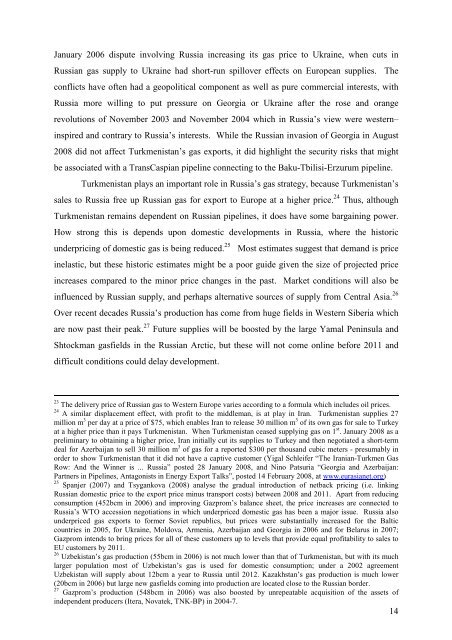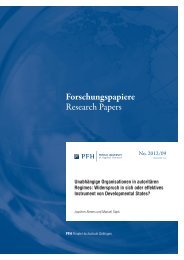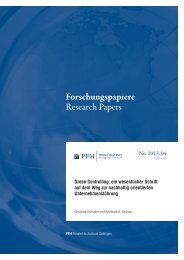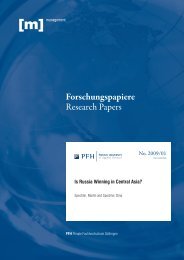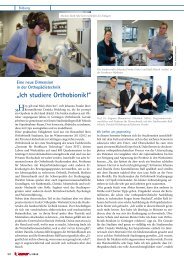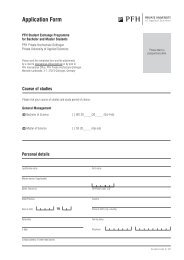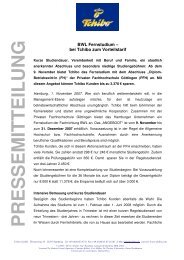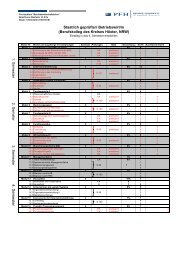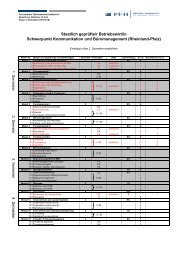Forschungspapiere Research Papers - PFH Private Hochschule ...
Forschungspapiere Research Papers - PFH Private Hochschule ...
Forschungspapiere Research Papers - PFH Private Hochschule ...
You also want an ePaper? Increase the reach of your titles
YUMPU automatically turns print PDFs into web optimized ePapers that Google loves.
January 2006 dispute involving Russia increasing its gas price to Ukraine, when cuts in<br />
Russian gas supply to Ukraine had short-run spillover effects on European supplies. The<br />
conflicts have often had a geopolitical component as well as pure commercial interests, with<br />
Russia more willing to put pressure on Georgia or Ukraine after the rose and orange<br />
revolutions of November 2003 and November 2004 which in Russia’s view were western–<br />
inspired and contrary to Russia’s interests. While the Russian invasion of Georgia in August<br />
2008 did not affect Turkmenistan’s gas exports, it did highlight the security risks that might<br />
be associated with a TransCaspian pipeline connecting to the Baku-Tbilisi-Erzurum pipeline.<br />
Turkmenistan plays an important role in Russia’s gas strategy, because Turkmenistan’s<br />
sales to Russia free up Russian gas for export to Europe at a higher price. 24 Thus, although<br />
Turkmenistan remains dependent on Russian pipelines, it does have some bargaining power.<br />
How strong this is depends upon domestic developments in Russia, where the historic<br />
underpricing of domestic gas is being reduced. 25 Most estimates suggest that demand is price<br />
inelastic, but these historic estimates might be a poor guide given the size of projected price<br />
increases compared to the minor price changes in the past. Market conditions will also be<br />
influenced by Russian supply, and perhaps alternative sources of supply from Central Asia. 26<br />
Over recent decades Russia’s production has come from huge fields in Western Siberia which<br />
are now past their peak. 27 Future supplies will be boosted by the large Yamal Peninsula and<br />
Shtockman gasfields in the Russian Arctic, but these will not come online before 2011 and<br />
difficult conditions could delay development.<br />
23 The delivery price of Russian gas to Western Europe varies according to a formula which includes oil prices.<br />
24 A similar displacement effect, with profit to the middleman, is at play in Iran. Turkmenistan supplies 27<br />
million m 3 per day at a price of $75, which enables Iran to release 30 million m 3 of its own gas for sale to Turkey<br />
at a higher price than it pays Turkmenistan. When Turkmenistan ceased supplying gas on 1 st . January 2008 as a<br />
preliminary to obtaining a higher price, Iran initially cut its supplies to Turkey and then negotiated a short-term<br />
deal for Azerbaijan to sell 30 million m 3 of gas for a reported $300 per thousand cubic meters - presumably in<br />
order to show Turkmenistan that it did not have a captive customer (Yigal Schleifer “The Iranian-Turkmen Gas<br />
Row: And the Winner is ... Russia” posted 28 January 2008, and Nino Patsuria “Georgia and Azerbaijan:<br />
Partners in Pipelines, Antagonists in Energy Export Talks”, posted 14 February 2008, at www.eurasianet.org)<br />
25 Spanjer (2007) and Tsygankova (2008) analyse the gradual introduction of netback pricing (i.e. linking<br />
Russian domestic price to the export price minus transport costs) between 2008 and 2011. Apart from reducing<br />
consumption (452bcm in 2006) and improving Gazprom’s balance sheet, the price increases are connected to<br />
Russia’s WTO accession negotiations in which underpriced domestic gas has been a major issue. Russia also<br />
underpriced gas exports to former Soviet republics, but prices were substantially increased for the Baltic<br />
countries in 2005, for Ukraine, Moldova, Armenia, Azerbaijan and Georgia in 2006 and for Belarus in 2007;<br />
Gazprom intends to bring prices for all of these customers up to levels that provide equal profitability to sales to<br />
EU customers by 2011.<br />
26 Uzbekistan’s gas production (55bcm in 2006) is not much lower than that of Turkmenistan, but with its much<br />
larger population most of Uzbekistan’s gas is used for domestic consumption; under a 2002 agreement<br />
Uzbekistan will supply about 12bcm a year to Russia until 2012. Kazakhstan’s gas production is much lower<br />
(20bcm in 2006) but large new gasfields coming into production are located close to the Russian border.<br />
27 Gazprom’s production (548bcm in 2006) was also boosted by unrepeatable acquisition of the assets of<br />
independent producers (Itera, Novatek, TNK-BP) in 2004-7.<br />
14


